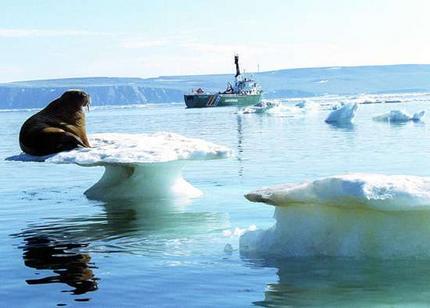Over the past few decades,
the Arctic has warmed at about twice the rate
of the rest of the globe. This has resulted in destabilisation of important Arctic systems, including sea ice, the Greenland Ice Sheet, mountain glaciers
and aspects of the Arctic carbon cycle. A peer-reviewed report dealing with the
subject was produced by WWF and brings together top climate scientists who
assessed the current science on Arctic warming and its global effects. Read on to find out more.
The report Arctic Climate Feedbacks:
Global Implications was presented on 2 September 2009 at the World
Meteorological Organization’s ‘World Climate Conference 3' in Geneva. It states that continued Arctic
warming could lead to global weather changes, flooding, which could affect one
quarter of the world’s people, and sudden increases in greenhouse gases
emissions from massive Arctic carbon pools.
What potential regional
impacts does the report predict?
The report emphasises that
changes in the Arctic are likely to affect everyone wherever we live,
but it does not often single out specific impacts on specific countries, as
that sort of fine-tuning of impacts requires further scientific investigation.
There are some country or regional-specific impacts in the report, as outlined
below:
(NB – these should all be
phrased as potential impacts)
Changes in air and water
currents could lead to wetter than normal conditions over central and southern
Europe and the Mediterranean, and drier than normal weather conditions over
Northern Europe, warmer than normal in Canada
and Northeastern US, potentially drier
American West.
- Europe and North America could
experience unusually cold winters, whereas Greenland
may experience unusually warmer winters. - Changes
in water temperatures and currents would have an impact on fisheries. For
example, the number of cod would increase in the Labrador
Sea and diminish on the northern European side. - Ocean
acidification, as a result of the ocean taking up additional carbon dioxide
from the atmosphere, is expected to hit the Arctic first because the Arctic Ocean already has a relatively low pH. This would
have potentially negative implications for shelled organisms that live on and
near the sea floor as well as for those animals that feed on the sea floor
ecosystem. - Sea-level
rise is a major concern for populations living in low-lying coastal regions
(about 25% of humans), because it will give rise to inundation (both temporary
and permanent flooding), wetland loss, shoreline erosion, salt water intrusion
into surface water bodies and aquifers, and it will raise water tables. In many
coastal regions of the world sea level is rising and the ground is sinking.
This amplifies the effect of sea-level rise in these locations, so that for
example, a half-metre rise in global sea-level and a half-metre of local land
subsidence combines to produce 1 metre of relative sea-level rise. - Accelerated
ground sinking has been reported in many regions, either because of local
groundwater withdrawal (e.g. Tokyo subsided by 5 metres, Shangai by 3 metres,
and Bangkok by 2 metres during the last decades) or oil and gas extraction
(e.g. along the Gulf of Mexico Coast in the United States where the ground
subsides at a rate of 5 to 10 mm per year).
The CABI internet resource Environment Impact provides many reports, articles and reviews on effects of global warming on the climate and on biological systems.
Photo:
Google Images
1 Comment
Leave a Reply


Ocean acidification is one of the most lethal yet least studied effects of global warming! This might be the silent killer of whales off Indian coasts recently.